[Page 210]
The Zionist Workers' Party “Histadrut”
by Haim Krajndler
Translated by Gloria Berkenstat Freund
At the beginning of the twenties, at the historic Prager Conference, the
Zionist Workers' Party Histadrut
was established with A. D. Gordin and Haim Arlozoroff at its head. This
organization also was established in our city. Its founders were several
members of Tseiri-Zion: Dovid Chaszczewacki, Shmuel Lachman and
Haim Krajndler.
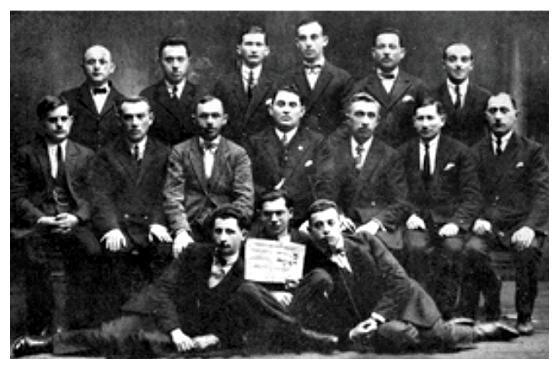 |
| A group of members of “Histadrut”
Standing: (From the Right): Y. Gruszka, Dovid Najman, Eli Gruszka, Dovid
Fajerman, Shmuel Lachman, Elimelekh Klajner
Sitting: Y. Zandberg, Meir Birnbaum, M. Wolkowicz, Dr. Tarla, Dovid
Chaszczewacki, Eli Kaplan, D. Erlichman
At the bottom: Zev Wolkowicz, Moishe Szitenberg, A. Lagrzycki
|
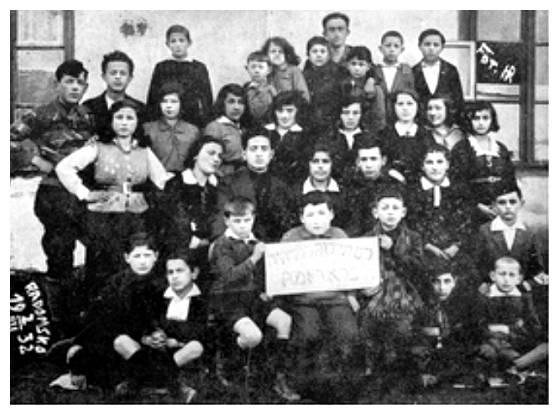 |
| A group of members of the Youth Organization “Gordonia”
|
The party had the smallest numbers of members. This was only
because it was the last to be established in a small city in which a lot of
parties had been active for many years. Nevertheless, Histadrut
was popular enough. It took an active part in the local funds (Keren Ha-Yesod,
the Permanent Fund for Benevolent Purposes; Keren Keyamet,
the Jewish National Fund) and also had a great influence on national political
life. It placed its principals on the ethical side of the Zionist idea.
The most serious young people, who had established a beautiful library named
the A.D. Gordin Library, grouped around Histadrut. The library was located
in a good meeting hall to which lecturers, entertainers and academics heading
the Keren Ha-Yesod and Keren Keyamet came from time to time.
The representative of our party in Keren Ha-Yesod was Mr. Yitzhak
Lachman, who organized many activities in this area.
When the party for various reasons had to liquidate the A. D. Gordin Library,
it was sent over to Rembertow.
At the head of Histadrut was a governing council to which the following
members belonged: Elimelekh Klajner, Dovid Chaszczewacki, Yehieil Meir
Wolkowicz, Dovid Erlichman*, Esther Szternfeld, Meir Birnbaum, Yehuda
Zandberg, Haim Krajndler, Eliezer Kaplan, Shmuel Lachman. Members of
this branch [of the organization were]: Dov Braner, Dovid Najman, Eiliyahu
Lagrzycki, Jakov Grushka, Eli Gruszka, Moishe Yitzhak Szitenberg, Yakov
Ofman, Zev Wolkowicz, Shmuel Rozencwajg, Dov Wajnsztok, Yakov
Zajdman, Yakov Gridberg, Shlomoh Szac, Rafal Dombrower, Emanuel Dombrower,
Dovid Fajerman, Fanye Goslowski, Aitche Majtlis, Gitl Gelbard and Ruchl Maneles.
Because of the significant role that they played in Radomsk's national Jewish
life, two leaders of Histadrut have earned special mention: Dovid
Chaszczewacki and Meir Wolkowicz.
Dovid Chaszczewacki was a Jew, a Ben Torah, and a devoted Zionist
with a lot of common sense and a healthy political sense. He was an
uncompromising foe of all kinds of insincere community benefactors,
against whom he would speak publicly with complete sincerity; he fought
them persistently. Because of his unwillingness to compromise, he was
called “the stubborn Litvak.” Essentially he was
good-hearted, and if something bad happened to a Jew, he became
deeply involved in[the situation and was literally moved to tears.
The words that he spoke to his friends when the ghetto in Radomsk came into
existence give testimony to his ability to grasp the realities and draw the
appropriate conclusions. “The Germans decided to annihilate us,” he
said. “Our duty is to organize a rebellion, to kill several score Germans,
to die as heroes and not let ourselves be slaughtered as lambs.”
* Later he joined the Revisionists.
[Page 211]
His words, alas, were not heeded and he shared the bitter destiny of our
Radomsk brothers.
Meir Wolkowicz was a zealous impractical Zionist. As a true man of the people
he dedicated himself with love and with his life to the work of Keren Ha-Yesod.
As a deputy he was incorruptible and drew himself to his work as to a holy
work. With a special reverence he would distribute the figs and bukser
(St. John's bread or carob pods) on the New Year's Day for trees [Tu B'Shvat,
the fifteenth day of Shevat which coincides with late January or February]
that were sent to the small children by the central Kehile Kadushe
(holy community).
When it pertained to political work he was very inconsistent and we endured a
lot of aggravation from him. So many times we had [disagreements] with him
when as co-editor of the Piotrkow weekly newspaper Undzer Zeitung
(Our Newspaper) he would not edit a report that needed a sharper assault on a
political opponent. We always found no changes had been made in the spirit of
the original text when we read the printed edition on Shabbos.
Meir died several years before the Second World War.
In 1929 a branch of Gordinia was created that was comprised of a
small number of children of Zionist parents who wanted to give their
children a Zionist education.
Preparatory training for prospective agricultural emigrants for kibbutzim
(collective farms] in Palestine was the reason [for the activity] in Radomsk.
Those being trained were members of Histadrut and Gordinia.
Some members of the preparatory training devoted themselves to the
educational work of the local branch of Gordinia. Several members of
Gordinia survived to emigrate to Israel.
[Page 211]
The Activity of the “Keren Kayemet Le-Yisroel” (Jewish National Fund)
Translated by Gloria Berkenstat Freund
by D. Akhi-Pinkhus
In 1901 the 5th Zionist Congress in Basle officially endorsed
Professor Herman [Zwi] Szpira's idea for the Keren Kayemet Le-Yisroel
(Jewish National Fund). The purpose of the Fund was to redeem the land of
Eretz-Yisroel from foreign hands with the help of the far-flung Jewish
masses. The Jewish masses quickly and with special feeling embraced the
Jewish National Fund in its first years.
Our mothers let the blue and white pushke of the K.K.L.
hang together with the pushke of Rebbe Meir. A lot of us still
remember how our mothers sent us to the vinegar maker Mr. Bril with the
K.K.L. pushke. He would empty it with such reverence. The people
[were infused] with the feeling of having been entrusted with a special mission.
Who doesn't remember the kerus * erev Yom-Kippur in the
synagogue and the Bote-Midroshim (houses of study and prayer)?
Or the K.K.L. collections at weddings and other simkhas?
Or even later the K.K.L. stamps with pictures of Dr. Max Nordau
and others?
* Translator's note: Plate put in synagogue on the eve of the Day of Atonement
for the collection of contributions
After the First World War, in 1922, the community-minded Zionist activist Meir
Wolkowicz, a friend of Histadrut, came to Radomsk. Through his initiative
the activities of K.K.Le-Yisroel were reorganized on a more business-like basis.
Despite all the prior activity a Zionist organization did not exist at that time. As
a matter of fact, Meir Wolkowicz together with Haim Goldberg organized several
groups, which took an active part in collecting for K.K.L.
At the end of 1925, Mr. M. Wolkowicz and Mr. H. Goldberg took part in a
regional meeting in Piotrkow. According to their report in 1925 the sum of
5,200 zlotys was collected in Radomsk. Furthermore the report explains that the old
Zionists did not participate in the work and only Histadrut, he-Halutz**
and Poalei Zion (together with the Zionist Socialist Worker's Party.)
fulfilled their appropriate duty.
** Translator's note: Movement begun in 1917 to prepare young Jews for
settlement in cooperative communities in Palestine, through labor, with
equality and mutual ownership of economic goods. Joseph Trumpeldor was a prime
inspiration for the movement.
At that time, Zionist activity in Radomsk encountered great difficulties. The
'flower' day for K.K.L. brought in a very small income, so that the
Radomsker Zeitung of September 9th, 1926 writes
about “The Devil Celebrating His Victory”: 'Mr. Wolkowicz
and his devoted co-workers do everything in order to revive the activities
of K.K.L. A heart-ringing deliverance will be managed: Every donor
leads to another, [urging] that he, too, should donate to the K.K.L.
The name of the donor will be published in the newspaper.' This feat was
crowned with great success and attracted an increasingly larger circle
of the Jewish population.
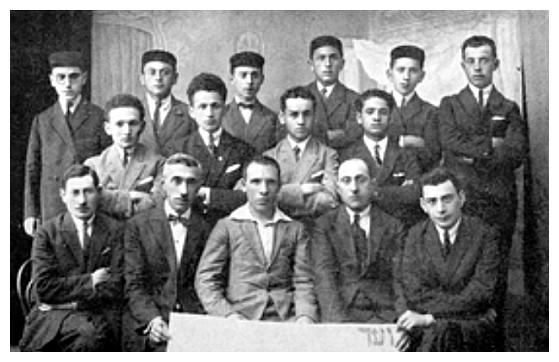 |
The Council of the “Keren Kayemet Le-Yisroel”
(Jewish National Fund) in 1926
Top row (from the right): Z. Wolkowicz, B. Margulewski, Y. Fridman, Y.
Rozencwajg, A. Ofman, Dovid Margulewski
Second row: A. B. Ajzen, Y. Liberman, H. Goldberg, M. Szitenberg
Sitting: Z. Ofman, Y. Zandberg, ______, Trustee (Messenger of Eretz-Yisroel),
M. Wolkowicz (Deputy), Meir Birnbaum
|
[Page 212]
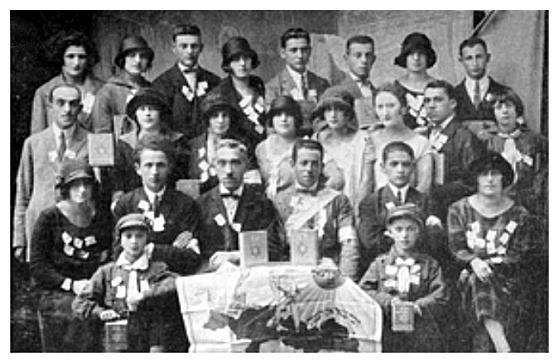 |
| During the conclusion of a 'flower campaign' for K.K.L.
Top row (from the right): A. Lagrzycki, Haiyyah-Pesye Goldberg, Z. Wolkowicz,
Shmul Najman, Haiyyah Zylberstajn,
Yitzhak Wajntreter, Ite Zelkowicz, Sarah Fiszman
Second row: _____, Bugajski, _____ Blum, _____, Miriam Baum, Rokhma Rozencweig,
Hana Goldberg, Gruszka
Third row: Esther Elbaum, A. B. Eisen, Zaydman, M. Wolkowicz, Haim Goldberg,
Hela Pariz
|
According to a report signed by Delegates Wolkowicz and Lagrzycki, the receipts
for the month of Tammuz in 1927 were 124.80 zl[otys].
The same report confirms that the income for 1927 was 1,007.80 zl.
That was also confirmed by the Auditor's Commission consisting of the
community workers B. Brauner and Sh. Lachman. In October 1928 during a visit by
the delegate of K.K.L. Central H. Azrakhi, the group Keren Kayemet Le-Yisroel
was created on the motion of H. Wolkowicz and others – at once from the
National Fund Committee – under the leadership of the following members:
chief deputy of the organization, Wolkowicz, vice deputy, Wolf Szpira,
treasurer, Yitzhak Lachman, Haim Goldberg, and Grundman. The division's
committee was made up of: B. Brauner, Y. Liberman, Szpria, Witenberg, and
Eichner. With the emergence of the youth group, the actions of K.K.L.
exceeded all expectations. Ignoring those in the circle of the older Jewish
population where an anti-Zionist mood plainly dominated, the great enthusiasm
of the young triumphed over all else, and income rose. In the month of
Tishrei 1928 73.00 zl. already had flowed in.
The Radomsker Zeitung of 23/12/1927 writes in connection with the
Chanukah campaign:
|
'We believe that the threatening black clouds have already passed from the
Radomsk sky… and the past neglect that people would show to the collector
will now find them happily fulfilling their duty as Jews with pleasure in
relation to the Jewish people in Eretz-Yisroel.'
|
In January 1928 M. Wolkowicz – for important personal reasons –
resigned his office as Deputy and during the visit of A. Bialopolski of the
Central organization, Eiliyahu Lagrzycki, was elected as Deputy, Sh. Najman as
Vice Deputy, Yitzhak Lachman treasurer and Dr. M. Kornberg secretary. The
intensity of the work increased still more [and] the group had numerous leaders.
Thanks to the work of the K.K.L. community activists, the anti-Zionist
atmosphere that was created by the 'Israeli expatriate' from Eretz-Yisroel,
who came to Radomsk was overcome. This shows in the income for K.K.L.
in the month of Tammuz 1928 with the sum of 170.19 zl. and
in the month of Tishrei 1928 the sum of 240.21 zl.
It must especially be underscored that above all in the list of the donors
there appear a large number of youngsters. One even finds a list of small
children with donations of…5 groshen. That shows how deeply
the work of the devoted community activists penetrated into the consciousness
of the young. 105.80 zl. had already flowed in from a flower day for K.K.L.
in the month of October 1928.
In January 1929, it was decided, at a meeting under the chairmanship of K.
Khaszczsewotski, to organize a committee of several members who would become
active with the K.K.L. work: Chaszczewacki, Klajner, Sh. Lachman
and Wolkowicz. It was also decided to increase the number of K.K.L. pushkes
and to organize the customary donations from the women for K.K. Le-Yisroel.
The presidium of the group, taking into consideration the devotion of the newly
created youth group and of the existing group, undertook the daring decision to
collect the sum of 1000 zlotys in the month of Tishrei 1929. In
the 'Radomsker Zeitung' of 15.12.29 we read:
|
'The efforts of the group were crowned with success. On the first of Heshvan
the receipts reached the sum of 1001.99 zl.'
|
Radomsk also took part in the organizing work for K.K.L.
in the county. Haim Goldberg was delegated to attend the meeting in Sosnowiec
that occurred in November 1929.
On a Chanukah night in 1929 Mr. Natan Ofman appeared on stage during an
artistic-musical performance and the income from the profits was 200 zl.
The Central organization decided to arrange a regional meeting in Radomsk on
the 23 rd of October 1930 in appreciation for the good showing of donors from Radomsk
for Keren Kayemet, with the participation of the regional delegates and A. Bialopolski, Member
Yekubson and Leah Widrowicz of the delegation from Eretz-Yisroel.
In respect for the city and residents and their community who participated in
the regional meeting in Radomsk and later were killed in the dark Hitlerite gehenem
(infernos), let us be permitted to record their names in the Yizkor Book of
Radomsk:
|
Apelsztajn and Szilis – Dzialoszyn; Flat[owicz?] and Grin – Brzeznica;
Rozenblum, Tenenbaum, Grinblat and Daychman – Przedborz; Khada Rukhel and
Reichman – from Klobuck; Unger – from Tomaszow; Kuszinski, Dawidowicz
and Platowicz – Sulmierzyce; Mlinarski – from Silew; Blusztejn and
Rozental – from Piotrkow; Yablonski, B. Lipszyc and Jochebed Lipszyc
– from Pajeczno; Gliksman – from Kleszczow; Szistak – from
Krzepice; Samber and Plawner – from Belchatow; Kawalski, Grojsman,
Tenenbaum and Chonowicz – from Kamiensk; Kamunic and Frenk – from
Krzepice; Marowicz – from Gorszkowice; [whom] together with local delegates
at the conference numbered 45.
|
[Page 213]
Some of them who miraculously survived the murderous extermination
campaign are found in Israel and, of course, other countries. So let these
words be a small recognition of their devoted work in behalf of our old-new
land of Israel. And for the dear community workers who shared the bitter fate
of their parents, sisters and brothers of Radomsk, let these words be a
bouquet of forget-me-not flowers on their unknown graves…
The Radomsker Zeitung of 28.2.1930 writes in detail about the
conference and what a passionate demonstration for Eretz-Yisroel
was staged. Over 500 Jews from Radomsk attended the proceedings. While the
speeches were interesting, more interesting was the greeting that demonstrated
how the K.K.L. and its devoted community workers had at last [silenced]
the anti-Zionist spirit in Radomsk.
Reb Najkron was welcomed in the name of the business leaders, who promised
material support for the K.K.L. M. Berger promised support from the small
merchants and he] declared:
|
“Zionism lives again in Radomsk. Although until now it found itself in a
lethargic sleep that was only because there was no one to wake it up.”
|
H. Krajndler (“Histadrut”) said:
|
“That the central [organization] of K.K.L. decided to arrange the
conference in Radomsk is a recognition that Radomsk participated at the
appropriately high level with its activity on behalf of our National Fund. It
recalls the past, when in Radomsk virtually only Histadrut supported
the work of K.K. Le-Yisroel. With great satisfaction, I affirm that Jews
come on their own initiative requesting pushkes for K.K.L.”
|
Haim Goldberg (from the Social Zionists) said in a report from Radomsk:
“After 1925, in the later years, when the receipts of K.K.L.
amounted to 7,000 zl. – together with the 'decline' of immigration to Palestine – there
was also a strong decline in income for K.K.L.
Thanks to devoted Zionist youth, and the fundraising group, the activity of the K.K.L.
again came back to life.”
For the year 1930, the Central organization designated the sum of 5,000 zl. for
Radomsk. The whole sum was raised.
On the 20 of Tammuz the Herzl Academy held a meeting with the participation of
Dr. Yitzhak Szifer from Warsaw, at which a protest-resolution passed against
the cut in immigration to Eretz-Yisroel.
In July 1930 we received from the main office of Keren Kayemet
in Israel the honor certificate that was inscribed in the Golden Book of Keren Kayemet
on behalf of Efroim Czizik who fell in battle protecting the Yishuv.
The registration was made on behalf of the Radomsk unit. Efroim Czizk was
killed while protecting the Hulda settlement south of Rehovot during the
uprising of 1929. It was the custom for Jewish communities to adopt the heroes
and inscribe them in the K.K.L. Golden Book. The certificate was signed
by Menahem Ussishkin, the head of the K.K.L.
Later, H. Chaszczewacki managed the group in place of H. Lagrzycki who left
office. In September 1930 [at] the general meeting of the group under the
chairmanship of H. Goldberg, the following managers were chosen: Wolkowicz,
Hartman, Goldberg, Ajzen, Eichner, Mila Goldberg, Lachman, Garfinkl, Y.
Liberman, M. Birnbaum and member Gitler.
[In] January 1931, Dr. A. Sh. Yuris from the head office of K.K.L.
in Jerusalem was delegated to Radomsk. The visit particularly had the effect
of expanding the activities of K.K.L.
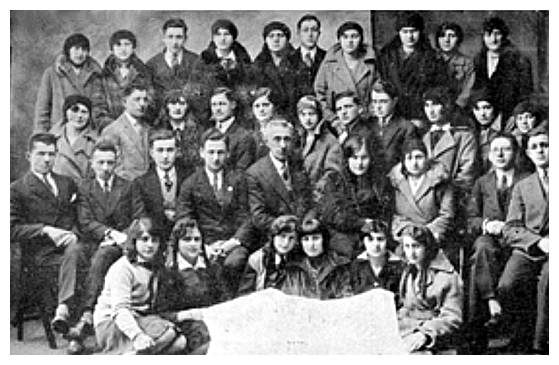 |
| The Youth Organization of K.K.L. in 1930
Top row (from the right): Fajerman, R. Gitler, M. Fajerman, D. Hartman, B.
Rubin, Sz. Zilberberg, Sz. Blumsztajn, N. Markowicz, G. Blumsztajn
Second row: Eichner, Ts. Gitler, L. Grundman, Y. Rozenbaum, Sz. Hartman, M.
Szpira, Seczemska, M. Rubin, Sz. Fajerman, D. Eichner, Ch. Grosman
Third row: Sz. Hampel, Ch. Hartman, M. Banker, M. Goldberg, M. Wolkowicz,
Rotenberg, Y. Rozenbaum, D.M. Korenberg, Yitzhak Lachman
Sitting: F. Sobol, R. Szpira, R. Bugajski, F. Gaslowski, A. Warszawski, G.
Jakubowicz
|
[Page 214]
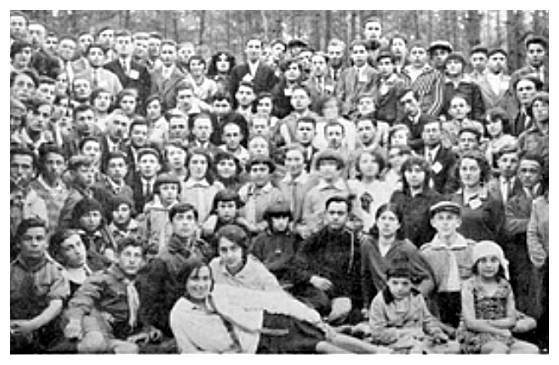 |
The community activists of the K.K.L., during the farewell for Member
Yehudah Liberman,
for his aliyah [immigration] to Eretz-Yisroel (8th of May, 1933)
Top row (from the right): D. M. Korenberg, Yitzhak Kupersztok, Daniel Eichner.
Mila Goldberg, Manya Szpira, R. Bialystok, Yakov Eichner, Leibel Szmulowicz
Second row: Yehezkeil Skurnicki, Yadzia Szmulowicz, Abner Garfinkl, Yehudah
Liberman, Haim Hartman, _____, Rafal Rapaport
[Sitting]: B. Kribus, ______, A. Gliksman, Warszawski, Grosman
|
For the 70th birthday of the great national leader Nahum Sokolow, the K.K.L.
group in Radomsk decided to collect telegrams with the signatures of the
Radomsk Jewish population and bind them. This Jubilee account would be sent
– through the auspices of the K.K.L. central organization – as a gift
of the Radomsk Jews.
In July 1931, the Radomsker Zeitung reported that the police interrupted a Herzl
Academy arranged by the group in the middle of the Academy's activities.
In August 1931 a memorial service in the city synagogue was arranged by K.K.L.
with the participation of H. Fogelman of the Central organization for the
fallen heroes in Eretz-Yisroel during the past two years. The group
also decided that the Tishrei action for K.K. Le-Yisroel
in 1931 should be carried out under the slogan '30 years of Keren Kayemet Le-Yisroel'
(1901-1931).
An interesting summary of the income for the years 1925-1930 shows very clearly
the Zionist spirit in Radomsk – in 1925 – 5,926 zl. income; 1926 –
2707 zl.; 1927 – 966 zl.; 1928 – 2701 zl.; 1929 – 960
zl.; 1930 – 5462 zl.; totaling – 15,992 zlotys.
In the first four months of 1931 there was a net income of 1,175.59 zl.
In July 1931, the Zionist activist M. Wolkowicz [the most successful money
raiser] gave up the management of the K.K.L. and in his place
a presidium of three members was elected as mentioned above
in the summary report about K.K.L: Yitzhak Lachman, Haim Hartman
and Shmul Najman.
In 1932-33 the presidium of K.K.L. consisted of the members: Yehudah Liberman
(in Israel), Abner Garkfinkel and Haim Hartman. The last two community activists were
killed by the German murderers.
In the last years [before the German invasion of Poland], the economic
situation for Polish Jewry in general grew worse, particularly in Radomsk.
Hitler's coming to power very strongly influenced the Polish anti-Semites with 'Azan'
in the lead to intensify the anti-Jewish policies, such as boycotts against
Jewish businesses. Naturally the receipts of K.K.L.
decreased from what they had been.
With publication of this article about the work of the K.K.L.
in Radomsk and their community activists in the Yizkor Book, we want to show
what a beautiful page the youth of Radomsk wrote in the history of Zionist
ideals.
This material is made available by JewishGen, Inc.
and the Yizkor Book Project for the purpose of
fulfilling our
mission of disseminating information about the Holocaust and
destroyed Jewish communities.
This material may not be copied,
sold or bartered without JewishGen, Inc.'s permission. Rights may be
reserved by the copyright holder.
JewishGen, Inc. makes no representations regarding the accuracy of
the translation. The reader may wish to refer to the original material
for verification.
JewishGen is not responsible for inaccuracies or omissions in the original work and cannot rewrite or edit the text to correct inaccuracies and/or omissions.
Our mission is to produce a translation of the original work and we cannot verify the accuracy of statements or alter facts cited.
 Radomsko, Poland
Radomsko, Poland
 Yizkor Book Project
Yizkor Book Project
 JewishGen Home Page
JewishGen Home Page
Yizkor Book Director, Lance Ackerfeld
This web page created by Max Heffler
Copyright © 1999-2026 by JewishGen, Inc.
Updated 23 Oct 2025 by LA








